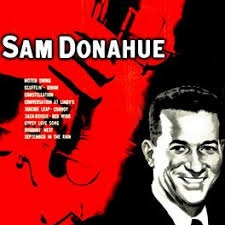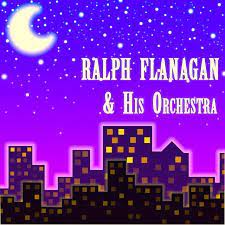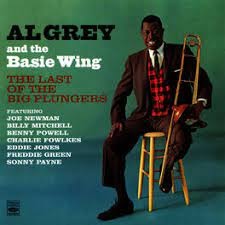
Daily Dose Of Jazz…
Samuel Koontz Donahue was born on March 18, 1918 in Detroit, Michigan and put together his first band when he was only 15 years old. He played in the bands of Gene Krupa, Harry James, and Benny Goodman. During World War II, he took over the US Navy band of Artie Shaw. After the war, he assembled and led a group that recorded extensively for Capitol Records.
He went on to create a new band enlisting trumpeters Harry Gozzard, Doc Severinsen, Wayne Herdell, arranger Leo Reisman, vocalists Frances Wayne, Jo Stafford and where Frank Sinatra Jr. spent time learning how to sing before it was dissolved in 1951. Then he re-enlisted in the Navy to serve in the Korean War.
His compositions included Quiet and Roll ‘Em with Gene Krupa, Convoy, LST Party, Scuttlin’, Love Scene, Please Get Us Out, Root Toot, Constellation, Conversation at Lindy’s, Saxa-Boogie, and Saxophone Sam. He went on to record with RCA Victor, Acrobat, Arista record labels.
Saxophonist Sam Donahue died from pancreatic cancer on March 22, 1974.
More Posts: bandleader,composer,history,instrumental,jazz,music,saxophone

Daily Dose Of Jazz..
Benny de Weille was born on March 6, 1915 in Lübeck, Germany. He studied clarinet under Hans Helmke and was heavily influenced by Benny Goodman, whom he often emulated in his own ensembles.
Benny made recordings with Teddy Stauffer, Hans Rehmstedt, and Willy Berking in the 1930s and 1940s. In 1940 he led his own Bar Trio. Following World War II he worked at Radio Frankfurt and conducted the Nordwestdeutscher Rundfunk Orchestra.
Clarinetist and bandleader Benny de Weille, whose last recordings were in a Dixieland style in 1951, died on December 17, 1977 in Westerland, Germany.
More Posts: bandleader,clarinet,history,instrumental,jazz,music

Daily Dose Of Jazz…
Harry Charles Prime was born on March 5, 1920 in Philadelphia, Pennsylvania. He graduated from St. Bridget’s Elementary and Roman Catholic High School. In the fall of 1944, he entered and won a singing contest at the 400 Club in Washington, D.C. and was offered a week’s engagement at the Club.
From there he proceeded to perform with big bands such as Randy Brooks, Tommy Dorsey, Jack Fina and Ralph Flanagan throughout the 1940’s and 50’s. Prime’s recording of the song Until with Tommy Dorsey sold a million records, but recording most of his hit songs with the Flanagan band.recording most of his hit songs with the latter.
In 1945, the Nations Disc Jockeys voted the Ralph Flanagan Band as the #1 band in the country and Prime was voted 20th best singer ahead of Dennis Day, Eddie Fisher and Dean Martin.
In the years following his tenure with the big bands, Prime never strayed far from the music business and worked as a disc jockey and radio host in various cities including WCAU in Philadelphia and WNPV in Lansdale.
His impeccable phrasing and vocal prowess led him to record Dear Hearts and Gentle People, Oh, What a Beautiful Morning, Nevertheless and Just One More Chance. He sits among the likes of Bob Eberle, Billy Eckstine, Dick Haymes, Frank Sinatra and Perry Como.
Prime recorded nearly 100 songs in the 1940s and 1950s, including Until, a million-seller with the Tommy Dorsey Orchestra. The song peaked at number four in the US chart.
Big band vocalist Harry Prime died on June 15, 2017 in Chalfont, Pennsylvania at age 97.
More Posts: history,instrumental,jazz,music,vocal

Daily Dose Of Jazz…
Charles Baker Fowlkes was born on February 16, 1916 in New York City and studied alto and tenor saxophone, clarinet, and violin before settling on the baritone saxophone. He spent most of his early career in the city playing with Tiny Bradshaw, Lionel Hampton, and Arnett Cobb.
He joined Basie’s orchestra in 1953 and remained with the orchestra until his death. The main interruptions during Charlie’s time with Basie were absences due to managing the career of his wife, vocalist Wini Brown.
Fowlkes recorded sixty-eight albums with Basie, and another fourteen with Frank Wess, Kenny Clarke, Buck Clayton, Stanley Cowell, Al Grey, Coleman Hawkins, Milt Jackson, Yusef Lateef, Billy Taylor, and Eddie “Cleanhead” Vinson.
Baritone saxophonist Charlie Fowlkes, who occasionally played flute, electric guitar, bass clarinet and vocals, died in Dallas, Texas on February 9, 1980.
More Posts: bass clarinet,flute,guitar,history,instrumental,jazz,music,saxophone,vocal

Daily Dose Of Jazz…
Gene Schroeder was born on February 5, 1915 in Madison, Wisconsin to a pianist mother and a father who was a trumpeter. He studied at the Wisconsin School of Music, and when he was 11 he was playing now and then with his father’s band, and doubling on clarinet in his high school orchestra a few years later.
After a year at the University of Wisconsin Music School, Schroeder moved to Milwaukee, Wisconsin. He led his own band and played with local musicians including Wild Bill Davison. His next move was to New York City in 1939 and was briefly with the Wes Westerfield Trio, then headed a combo. Gene went on to spend a year apiece as a member of the groups of Joe Marsala and Marty Marsala.
By the summer of 1942, Schroeder was working again with Wild Bill Davison then beginning in 1943 at Nick’s with Miff Mole. After becoming Eddie Condon’s regular pianist, he played at the opening of the club Condon’s in 12 1945. He was with Condon most of the time from then on up to 1962 appearing on many recordings. During his long association with Condon’s Chicago jazz bands his talent was continually overshadowed, most likely due to his being a subtle player.
He had a three year stint with the Dukes of Dixieland from 1961 to 1964 and then worked in the late ’60s with Tony Parenti. Despite his busy activity, he only led one recording session in his career, four songs cut in 1944 for the Black & White label with a trio.
Pianist Gene Schroeder died at the age of 60 on February 16, 1975 in his hometown of Madison.
More Posts: bandleader,history,instrumental,jazz,music,piano



